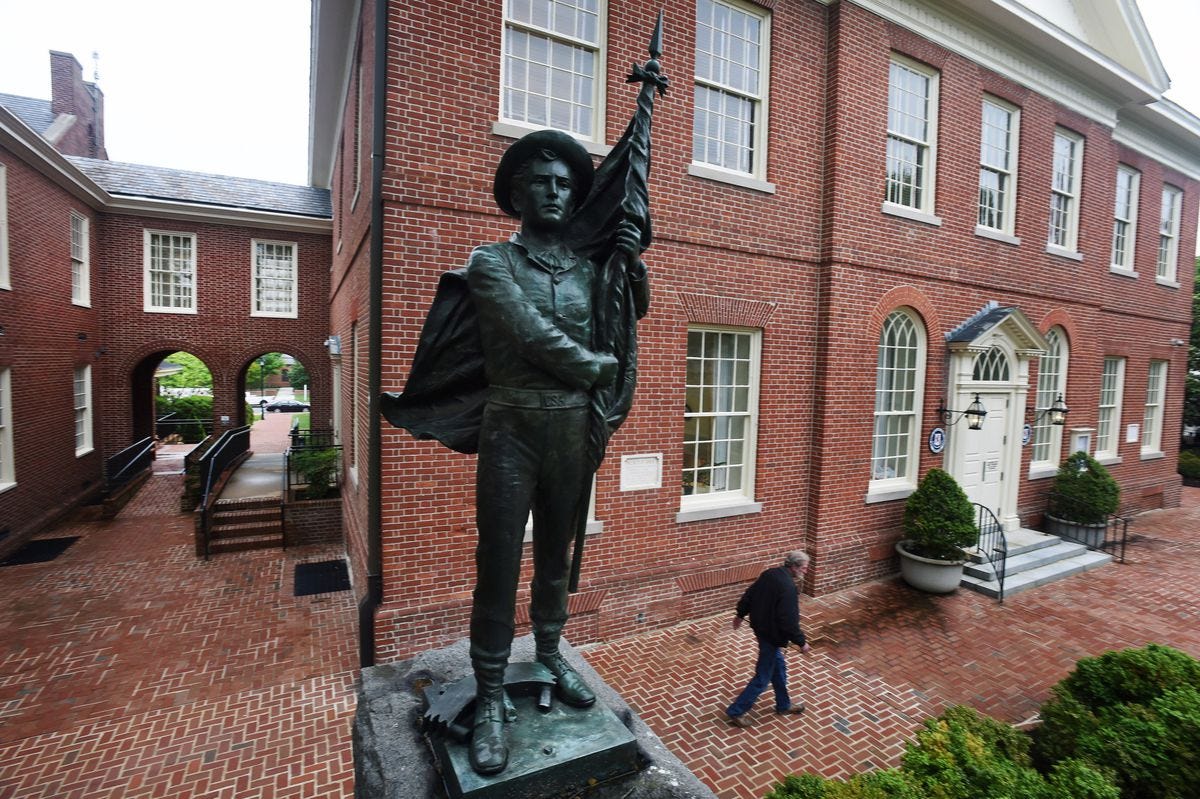The Fate of Confederate Monuments
Does it matter where Confederate monuments end up once they are removed?
Earlier today the Confederate “Talbot Boys” statue was removed from in front of the courthouse in Easton, Maryland, where it had stood since 1916. It will be relocated to the Cross Keys Battlefield in Harrisonburg, Virginia. The removal of the statue brings the total number of removals since the police murder of George Floyd in May 2020 to 112.
Some have questioned whether it is appropriate to relocate the statue to a Virginia battlefield. Such concerns raise the broader question of what, if any, considerations should be weighed by local governing bodies once the decision to remove a monument has been made.
A number of solutions have been implemented in recent years. Communities have transferred Confederate monuments from prominent public spaces to local cemeteries. The city of Dallas transferred a large equestrian monument of Robert E. Lee to a private golf course. The Virginia Military Institute recently relocated a statue of Confederate general Thomas “Stonewall” Jackson to the Virginia Museum of the Civil War and New Market Battlefield State Historical Park. Last summer the city of Charlottesville voted to donate the Robert E. Lee monument to the Jefferson School African American Heritage Center, which plans to melt down the statue and use the bronze to create a new public artwork. In the former capital of the Confederacy, the decision has been made to donate its Confederate monuments to the Black History Museum and Cultural Center, where they will be interpreted for the general public.
Ultimately, these decisions need to be made at a local level and while there is no one solution that dictates what should happen to these monuments, this doesn’t mean that serious deliberation isn’t required.
Local city councils and other governing bodies have a responsibility to reassure, both their own citizens and those living elsewhere, that the problems posed by a monument are not simply passed from one community to another. If the location of a Confederate monument in a prominent public space presented a problem for local residents, it would be a grave mistake to transfer it elsewhere knowing that it would be rededicated in a similar space.
Thankfully, that doesn’t seem to have happened thus far.
Still, some may see the decision to relocate the “Talbot Boys” statue to a battlefield as problematic. They are not wrong.
The long history of these monuments stretching back to the Jim Crow era and the pain they have caused for so many is not simply erased as a result of being relocated. The staff at Cross Keys and New Market Battlefield have a responsibility to acknowledge the long and problematic history of their new acquisitions for their visitors.
At the same time, I think it is safe to say that the sting of these monuments has been blunted as a result of having been relocated. Few people who visit Civil War battlefields are shocked to come face to face with a Confederate statue and those people who would rather avoid them can easily do so. Handled properly, the “Talbot Boys” may actually help to educate the public.
In the end, the benefits for a community that has chosen to remove a Confederate statue far outweigh the thought of it being relocated to a battlefield. This is especially the case in reference to monuments that were dedicated in front of courthouses during the Jim Crow era—buildings that should always be welcoming to all residents.
It goes without saying that not everyone involved in the push to remove a Confederate monument is going to be satisfied with the decision of where to relocate it.
For the residents of Easton, Maryland, however, there are more pressing questions to address right now, beginning with how to repair the damage that the debate has done to the community and deciding what, if anything, should replace the statue.
If you enjoyed this post please consider subscribing. Once you do your email address will be entered in a drawing to win a copy of my latest book, Searching for Black Confederates: The Civil War’s Most Persistent Myth. What do you have to lose?





All the monuments I have read about seem to be of some historical and/or artistic significance. How about the rest? In Blanco (I think it was) Texas I've seen a decent-enough bronze in the style of the 1890s, but put up in the 1930s - presumably makework in the Depression. Also in Texas, some resort villages by artificial lakes that didn't exist until the 20thC have crude cast-concrete Confederate soldiers - presumably put up on the assumption that that's what tourists expect to see in the South. Should go for landfill, IMO.